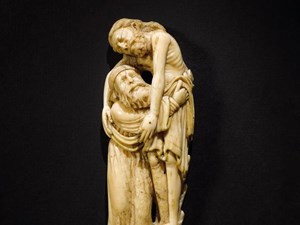
The V&A is seeking to acquire and save a rare 12th-century Walrus ivory carving, depicting the Deposition of Christ from the Cross, for the nation, following a temporary export bar placed in November 2023 by the Department for Culture, Media and Sport.
The intricate carving, which was previously on long-term loan to the V&A from 1982 to 2022, is heralded as one of the finest and most important examples of English Romanesque ivory carving to survive today.
A recommendation to the Secretary of State was made by The Reviewing Committee on the Export of Works of Art and Objects of Cultural Interest, which is supported by the Arts Council, that the Deposition from the Cross was of national importance and should be export deferred to allow institutions and individuals in the UK to retain it in the country for the public to enjoy.
The V&A must fundraise for the entire £2 million cost of the acquisition and having recently launched its fundraising campaign, is seeking donations to acquire the piece for its permanent collection, where it will return to public view.
The successful acquisition of the Deposition from the Cross by the V&A would allow for the sculpture to be re-united with the only known surviving piece of the same ensemble, a fragmentary ivory carving of Judas at the Last Supper, discovered in Wakefield during the 18th-century, which is currently in the V&A Collection. Together, both carvings would have likely once formed part of a larger work showing scenes from the Passion of Christ, including the Crucifixion. At V&A South Kensington, the two pieces were exhibited side-by-side for decades.
Dr. Tristram Hunt, Director of the V&A, said: “The Deposition from the Cross ivory is one of the most beautiful, entrancing and historically important items to have been on display at the V&A. It tells the story of humanism long before the Renaissance and speaks to an elemental part of English culture. It is vital that we return it to display, for free, for everyone, forever.”
James Robinson, Acting Director of Collections at the V&A, said: “This compelling work offers a rare, tantalising glimpse of the sophistication and emotional power of art in
England in the Middle Ages, a legacy that was almost entirely obliterated by the iconoclastic ravages of the Reformation. It was made at a time when Church doctrine struggled to explain the mysteries of the Incarnation and, in this way, it is evidence of the pivotal role that the visual arts played in conveying devotional developments.”
The Deposition is dated to about 1190-1200, and is likely to have been made in York, North Yorkshire, one of the UK’s most important medieval centres of artistic patronage, trade and religion.
A revealing example of the craftsmanship and taste at the highest levels of society in the north of England in the late 12th-century, the Deposition depicts the moment in the story of the Passion of Christ in which Jesus’s body is lifted down from the cross by Joseph of Arimathea. Unique and intimate in its treatment of the subject’s expressions and gestures, the Deposition has attracted praise for both its masterful skills of ivory carving, and its embodiment of feelings of human suffering, empathy and compassion.
The Deposition offers a fascinating glimpse into the art and craftsmanship of England during the Middle Ages, having survived the widespread destruction of religious art and imagery during the English Reformation of the 16th-century. An exceptionally rare piece, it continues to prove an invaluable source in the research and study of cultural heritage and history in England and beyond, from patronage and taste in the Romanesque period, to the use global trade networks and environmental impact of historic sourcing of materials.
Extraordinary in its quality and condition, the Deposition ranks alongside two 12th- century Romanesque objects of outstanding national importance which are already part the V&A’s collection: the Gloucester Candlestick, given to the Abbey (now cathedral) of St. Peter, Gloucester by Peter, Abbot from 1104-1113 and the Becket Casket reliquary enamelled with scenes from the life of St Thomas Becket.
The carving was on long-term loan to the V&A for 40 years until 2022. It has been exhibited at The Metropolitan Museum of Art (1970) and Hayward Gallery (1984).

ArtDependence Magazine is an international magazine covering all spheres of contemporary art, as well as modern and classical art.
ArtDependence features the latest art news, highlighting interviews with today’s most influential artists, galleries, curators, collectors, fair directors and individuals at the axis of the arts.
The magazine also covers series of articles and reviews on critical art events, new publications and other foremost happenings in the art world.
If you would like to submit events or editorial content to ArtDependence Magazine, please feel free to reach the magazine via the contact page.